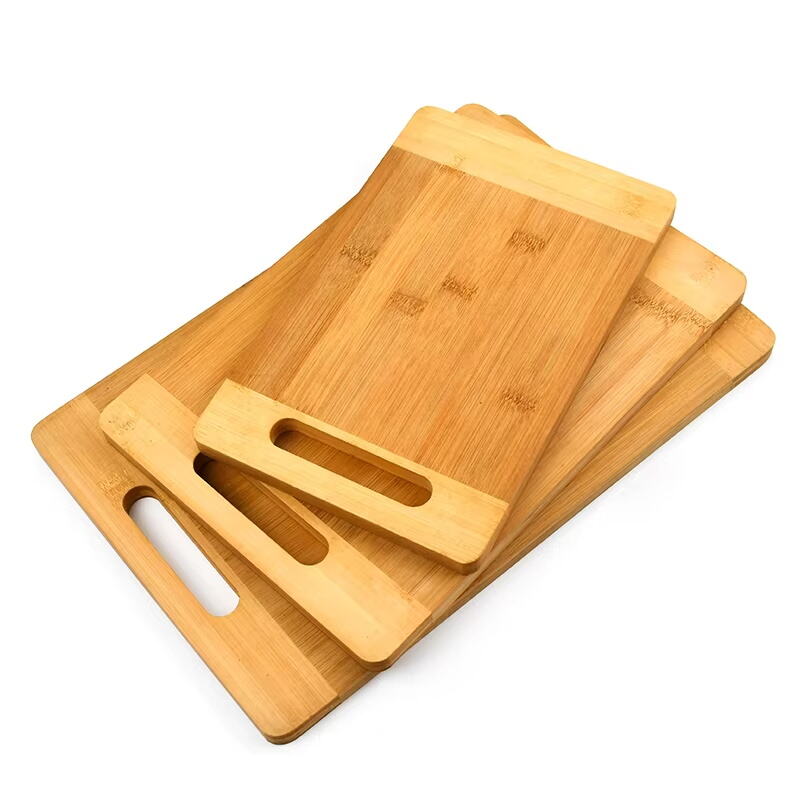Essenzieller Leitfaden für Küchenschneidebretter aus Holz
Gut ausgewählt holzschneidbrettset bildet die Grundlage jeder funktionellen Küche. Egal, ob Sie ein professioneller Koch oder ein Hobbykoch sind – die richtige Wahl der Schneidebretter kann Ihre Lebensmittelzubereitung erheblich beeinflussen. Hochwertige holzschneidbrettset schneidebretter bieten nicht nur eine sichere und stabile Oberfläche zum Schneiden und Hacken, sondern verleihen Ihrer Küchendekoration auch eine natürliche Ästhetik und schützen gleichzeitig Ihre wertvolle Messersammlung.
Beim Kauf eines Holzschneidebretts schneidebrett-Set , wählen Sie mehr als nur Küchenwerkzeuge – Sie entscheiden sich für Artikel, die zu einem festen Bestandteil Ihrer täglichen Kochroutine werden. Das richtige Set wird Ihnen viele Jahre lang dienen, eine edle Patina entwickeln und dabei ihre Funktionalität und ästhetische Ausstrahlung behalten. Lassen Sie uns alles Wichtige zum Kauf des perfekten Holzschneidebrettsystems für Ihre kulinarischen Bedürfnisse erläutern.

Verschiedene Holzarten im Vergleich
Harte Holzsorten für Schneidebretter
Die Art des Holzes, aus dem Ihr Schneidebrett-Set gefertigt ist, beeinflusst entscheidend dessen Langlebigkeit und Funktionalität. Ahorn ist eine besonders empfehlenswerte Wahl, da er eine außergewöhnliche Härte und eine hohe Widerstandskraft gegen das Bakterienwachstum bietet. Seine feine, enge Maserung macht ihn weniger anfällig für Schnittspuren und Wasserabsorption und sorgt so für eine lange Lebensdauer Ihres Schneidebrett-Sets.
Walnuss bietet eine weitere hervorragende Option, mit einer dunkleren Färbung, die Flecken und Messermarkierungen elegant kaschiert. Obwohl etwas weicher als Ahorn, macht die natürliche Schönheit und Langlebigkeit der Walnuss sie zu einer beliebten Wahl für hochwertige Holzschneidbrett-Sets. Buche und Kirschholz bieten ebenfalls zuverlässige Alternativen, da sie Langlebigkeit mit attraktiven Maserungen verbinden.
Gehrungsholz im Vergleich zu Kantenholz
Die Bauweise Ihres Holzschneidbretts beeinflusst sowohl seine Leistungsfähigkeit als auch seine Langlebigkeit. Gehrungsholzbretter, bei denen die Holzteile so angeordnet sind, dass die Maserung vertikal verläuft, bieten eine überlegene Langlebigkeit und Selbstheilungseigenschaften. Diese Bretter nehmen die Schläge durch Messer besser auf, wodurch sowohl die Schneidfläche als auch Ihre Messer weniger beansprucht werden.
Kantenbretter, bei denen Holzstücke nebeneinander mit der Maserung waagerecht verlegt werden, bieten eine kostengünstigere Alternative, wobei sie eine gute Langlebigkeit beibehalten. Obwohl sie im Vergleich zu Stirnbrettern stärker Schnittspuren zeigen können, hilft die richtige Pflege dabei, viele Jahre lang gut zu funktionieren.
Größen- und Dickenüberlegungen
Optimale Brettmaße
Ein umfassendes Holzbrett-Set enthält in der Regel mehrere Größen, um unterschiedlichen Aufgaben gerecht zu werden. Ein großes Brett mit etwa 45 x 60 cm dient als Hauptarbeitsfläche für die umfangreiche Essensvorbereitung. Mittelgroße Bretter von ca. 30 x 40 cm sind ideal für alltägliche Schneidearbeiten, während kleinere Bretter mit 20 x 25 cm gut für schnelle Arbeiten wie das Schneiden von Obst oder das Hacken von Kräutern geeignet sind.
Die Dicke Ihrer Schneidbretter spielt ebenfalls eine wesentliche Rolle. Die Bretter sollten mindestens 1,5 Zoll dick sein, um ein Verziehen zu verhindern und während der Nutzung Stabilität zu bieten. Hochwertige Holzschneidbrett-Sets beinhalten häufig Bretter unterschiedlicher Dicken, wobei größere Bretter dicker sind, um eine höhere Langlebigkeit zu gewährleisten.
Lagerung und Platzmanagement
Beim Kauf eines Holzschneidbrett-Sets sollten Sie Ihre Küchenlagerkapazität berücksichtigen. Die Bretter müssen bequem in den verfügbaren Schrankplätzen oder auf Arbeitsflächen untergebracht werden können. Achten Sie auf Sets mit integrierten Lagelösungen, wie z. B. stehende Ablagegestelle oder wandmontierte Halterungen, um die Platznutzung optimal zu gestalten und gleichzeitig eine einfache Zugänglichkeit der Bretter zu gewährleisten.
Einige Holzschneidbrett-Sets sind mit Brettern ausgestattet, die ineinander gestapelt werden können, um bei der Aufbewahrung Platz zu sparen – eine hervorragende Eigenschaft für kleine Küchen. Denken Sie daran, ausreichend Platz für eine ordnungsgemäße Luftzirkulation zwischen den gelagerten Brettern einzuplanen, um Feuchtigkeitsansammlungen und ein mögliches Verziehen vorzubeugen.
Wartungs- und Pflegeanforderungen
Tägliche Reinigungspraktiken
Die Pflege Ihres Holzschneidbrettsatzes erfordert eine gleichmäßige Pflege, um eine lange Lebensdauer zu gewährleisten. Reinigen Sie die Bretter nach jedem Gebrauch mit warmem Wasser und mildem Seife, und bürsten Sie sie vorsichtig mit einer weichen Bürste oder einem Schwamm. Vermeiden Sie das Einweichen der Bretter, da eine übermäßige Wassereinwirkung zu Verformungen und Rissen führen kann. Trocknen Sie die Bretter anschließend gründlich mit einem sauberen Tuch und stellen Sie sie senkrecht auf, damit sie vollständig trocknen können.
Regelmäßiges Desinfizieren trägt zur Lebensmittelsicherheit bei. Eine Lösung aus weißem Essig oder verdünnter Bleiche kann Ihre Bretter effektiv desinfizieren, vergessen Sie jedoch nicht, diese danach gründlich abzuspülen und vollständig zu trocknen. Manche Holzschneidbrettsätze enthalten Pflegehinweise, die spezifisch für die Holzart und die Herstellungsmethode sind.
Langfristige Konservierungstechniken
Eine monatliche Pflege mit lebensmittelechtem Mineralöl oder spezieller Holzpflegecreme hilft dabei, Ihr Holzschneidebrett-Set vor dem Austrocknen und Rissbildung zu schützen. Tragen Sie das Öl großzügig auf, lassen Sie es über Nacht einziehen und wischen Sie danach überschüssiges Öl ab. Diese Behandlung bildet eine schützende Barriere gegen Feuchtigkeit und versorgt das Holz mit wichtigen Pflegestoffen.
Bei stark beanspruchten Brettern kann eine periodische Auffrischung erforderlich sein. Leichtes Schleifen kann tiefe Messereinschnitte entfernen und eine glatte Oberfläche wiederherstellen. Anschließend gründlich reinigen und erneut mit Öl behandeln. Viele hochwertige Holzschneidebrett-Sets enthalten Pflegemittel und detaillierte Anweisungen zur Pflege, um die Langlebigkeit und Optik zu bewahren.
Investitions- und Wertüberlegungen
Qualitäts- und Preisvergleich
Ein hochwertiges Holzschneidebrett-Set stellt eine bedeutende Anschaffung für die Küche dar, wobei die Preise je nach Holzart, Verarbeitung und enthaltenen Teilen von moderat bis gehoben variieren. Obwohl preisgünstige Optionen erhältlich sind, erweist sich die Investition in ein qualitativ hochwertiges Set langfristig oft als wirtschaftlicher, da gute Bretter bei angemessener Pflege mehrere Jahrzehnte halten können.
Berücksichtigen Sie das Wertversprechen verschiedener Sets, einschließlich Faktoren wie Garantieumfang, enthaltene Accessoires und Herstellerunterstützung. Hochwertige Holzschneidebrett-Sets können ergänzende Artikel wie Pflegeprodukte, spezielle Reinigungswerkzeuge oder Aufbewahrungslösungen enthalten, die ihren Gesamtwert steigern.
Langfristige Kostenvorteile
Qualitativ hochwertige Holzschneidebretter-Sets bieten eine hervorragende Kapitalrendite durch reduzierten Ersatzbedarf und verbesserte Küchenfunktionalität. Gut gepflegte Bretter schützen teure Messerkanten und können im Laufe der Zeit Hunderte von Euro an Kosten für Messerersatz oder Schärfen sparen. Zudem widerstehen hochwertige Bretter bakteriellem Wachstum besser als günstigere Alternativen, fördern die Lebensmittelsicherheit und verringern das Kontaminationsrisiko.
Viele hochwertige Holzschneidebretter-Sets werden mit lebenslangen Garantien gegen Produktionsfehler geliefert, was zusätzliche Wertbeständigkeit bietet. Die Langlebigkeit und zeitlose Ästhetik gut gearbeiteter Holzbretter trägt zudem zum ästhetischen Wert Ihrer Küche bei und kann potenziell den Gesamtwert Ihres Zuhauses steigern.
Häufig gestellte Fragen
Wie oft sollte ich mein Holzschneidebretter-Set ölen?
Zur optimalen Pflege sollten Sie alle 4–6 Wochen Speiseöl auf Ihre Holzschneidebretter auftragen, oder häufiger, falls das Holz trocken oder stumpf erscheint. Täglich verwendete Bretter benötigen möglicherweise häufigeres Ölen, während seltener genutzte Bretter alle 2–3 Monate behandelt werden sollten.
Kann ich mein Holzschneidebrett-Set in die Spülmaschine geben?
Stellen Sie Holzschneidebretter niemals in die Spülmaschine. Die hohe Hitze und die langanhaltende Nässe führen zu Verformungen, Rissen und möglicherweise sogar zum Auseinanderbrechen der Holzteile. Reinigen Sie die Bretter immer per Hand mit warmem Wasser und mildem Spülmittel, und trocknen Sie sie danach gründlich.
Wie entferne ich starke Gerüche von meinem Holzschneidebrett?
Um hartnäckige Gerüche zu beseitigen, bestreuen Sie das Brett mit grobem Salz, reiben Sie es dann mit einer halben Zitrone ab und lassen Sie die Mischung einige Minuten einwirken. Spülen Sie das Brett gründlich mit warmem Wasser ab, trocknen Sie es vollständig und tragen Sie bei Bedarf eine dünne Schicht Mineralöl auf. Diese natürliche Reinigungsmethode entfernt Gerüche effektiv und ist gleichzeitig schonend zum Holz.



 Startseite
Startseite